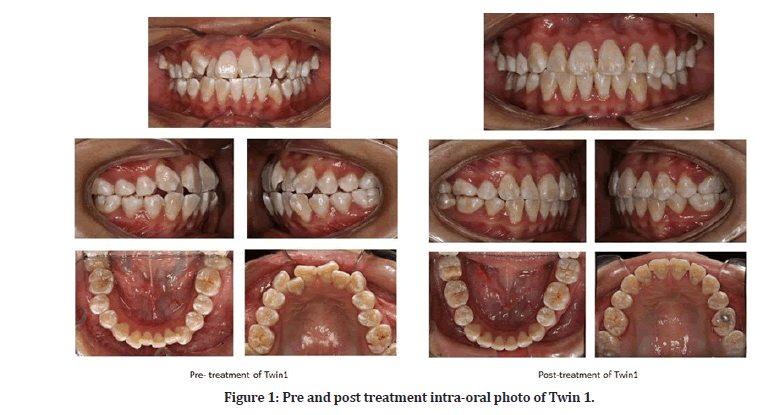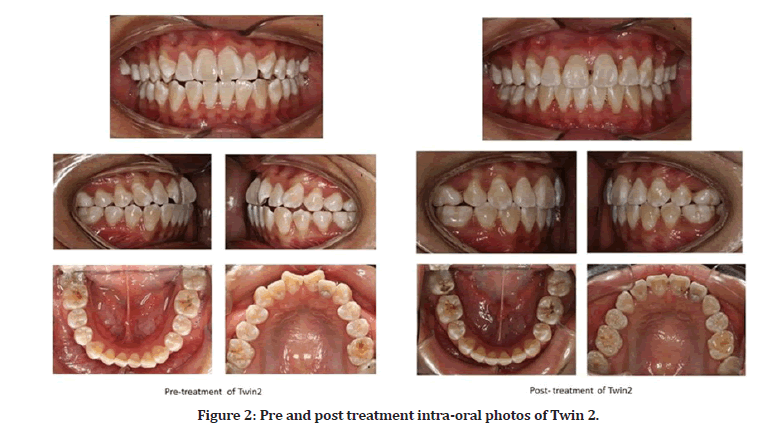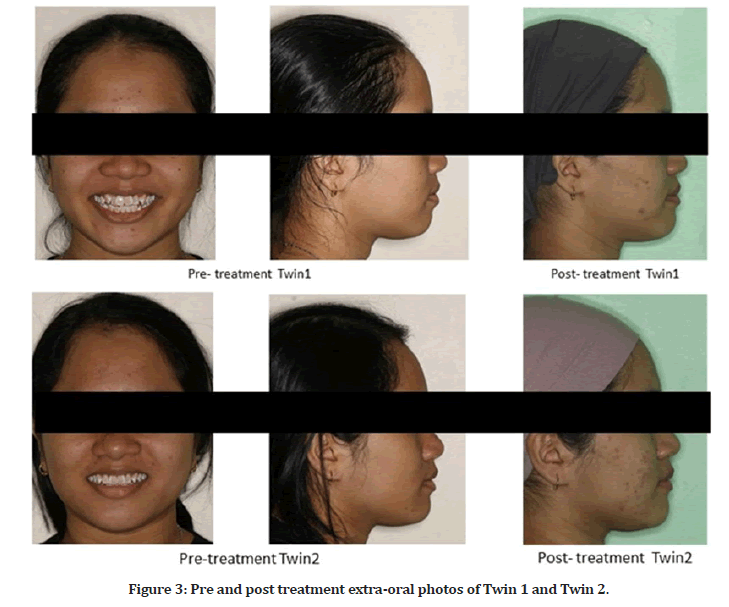Research - (2022) Volume 10, Issue 11
Genetic Influence of Class III Bimaxillary Proclination: A Case Report of Monozygotic Twins
*Correspondence: Liyana Ghazali, Orthodontic Unit, School of Dental Sciences, University Sains Malaysia, Kota Bharu, Kelantan, Malaysia, Email:
Abstract
Introduction: Dental bimaxillary proclination is a common malocclusion among Asian and Afro-Caribbean population. Facial aesthetics is normally the primary concerns of the patients which characterized by protrusive and proclined upper and lower incisors with increased lips procumbency. Patients may be presented with anterior open bite, incompetent lips and gummy smile. Aim: The aim is to highlight the genetic influence in development of dental malocclusion: dental proclination. Case history: Cases of a pair of monozygotic female twins with Class III incisor relationship with bimaxillary proclination of upper and lower incisors on Class 1 skeletal pattern with average vertical proportion are presented. Both patients exhibited similar craniofacial and dental features undergone orthodontic camouflage to improve dental conditions. Pre and post cephalometric findings were found to be identical in both patients. Discussion: Genetic plays a major role in development of dental malocclusion which was clearly exhibited in monozygotic twins.
Keywords
Dental malocclusion, Monozygotic twins, Bimaxillary proclination, Genetic influence
Introduction
Dental bimaxillary protrusion or better known as bimax is another common malocclusion among Asian and Afro- Caribbean population with prevalence as high as 68.8% [1]. This condition is characterized by protrusive and proclined upper and lower incisors with an increased in procumbency of the lips [2]. Facial aesthetics is the primary concern of the patients as this condition is associated with incompetence lip, gummy smile and in worse condition, anterior open bite. The aetiology of bimaxillary is multifactorial involving genetic and environmental causes. Typical orthodontic treatment includes orthodontic camouflage [3] and in more severe cases might require orthognathic surgery.
Twin studies are a special type of epidemiological studies designed to measure the contribution of genetics as opposed to environment in phenotypic expression [4]. Monozygotic twins have similar genes are compared with dizygotic twins who shared only half of their genes by assuming the environmental influence are the same for in both groups [5]. Therefore, in this study, we would like to highlight the role of genetic influences of monozygotic twins on development of bimaxillary proclination of upper and lower incisors in Class 1 skeletal pattern patients.
Case Report
A 18-year-old identical Malay female twins in good health, presented with chief complaint of crowding of anterior teeth. Patients have no relevant past medical and allergy history. Frontal examination showed both patients have symmetrical face with 90% of incisors shown upon full smiling and upper dental midline coincident with facial midline. From lateral view, both patients exhibited straight profile with average nasolabial angle and labiomental fold. Vertical assessment of the face showed average Frankfort mandibular plane angle and lower face height.
The twins have complete permanent dentition with generalized fluorosis with palatal caries of UL2 on Twin2 (Figures 1 and Figure 2). Both had moderate crowding of upper with palatally displaced lateral incisors and distolabially rotated upper central incisors. In the lower arch with real mirror image of both twins showed moderate crowding of anterior segments with impeded mesioangulated LR7. In Twin1, lower second premolar was temporarily restored. In occlusion, both patients had Class III incisor relationship with edge-to-edge bite, Class I molar and Class II bilateral canine relationships. The severity of presenting malocclusion especially the crowding was greater in Twin1 as compared to Twin2.

Figure 1: Pre and post treatment intra-oral photo of Twin 1.

Figure 2: Pre and post treatment intra-oral photos of Twin 2.
Cephalometric analysis revealed significant resemblance between the two twins. Both twins have SNA of 83o, SNB of 79o and average ANB of 3.5o showing a Class 1 skeletal pattern with average vertical proportion. Their upper and lower incisors are proclined with reduced interincisal angles (Table 1). Canine relationships were Class II in both patients.
| Measurement | Pre-treatment Twin1 | Near-end treatment Twin1 | Pre-treatment Twin2 | Near- end treatment Twin 2 |
|---|---|---|---|---|
| SNA (0) | 83.1 | 83.8 | 83.4 | 84.7 |
| SNB (0) | 79.6 | 80.2 | 79.6 | 80.9 |
| ANB (0) | 3.5 | 3.6 | 3.8 | 3.7 |
| MMPA (0) | 23.8 | 22.6 | 20 | 19.7 |
| LFH ratio % | 54.7 | 54 | 53.9 | 54.8 |
| UI-Mx (0) | 117.3 | 112.5 | 117.6 | 108.2 |
| LI-Mn (0) | 110.2 | 95.3 | 110 | 95.8 |
| IIA (0) | 108.6 | 130.87 | 112.7 | 137.2 |
Table 1: Comparison of cephalometric analysis of Twin 1 and Twin 2.
Treatment plan
For Twin1, extraction pattern of class III incisor relationship was chosen by Clinician1 by extracting upper second premolars and lower first premolars. Anchorage was reinforced in the upper using trans palatal arch. For Twin2, Clinician2 decided to extract upper first and lower second premolars. Due to extraction pattern, anchorage was deemed to be low, and no reinforcement was placed.
Treatment progress
MBT appliance 0.022x0.028” bracket slots were used for bonding in the upper and lower arch with banded first molars. In Twin1, a transpalatal arch was fitted on maxilla to enhance anchorage. Extractions of the bicuspids was done prior to bond-up and alignment and levelling were successfully achieved following sequence of arch wires; 0.014”, 0.018”, 0.018x0.025” nickel- titanium (Niti) and finished with working archwire of 0.019x0.025” stainless steel. Retraction was accomplished using elastomeric chain. Mesioangulated lower right second molar was uprighted using pushcoil spring and secondary 0.016” Niti arch wire. Finishing and detailing was carried out using 0.019x0.025” titanium molybdenum alloy (TMA).
Cases were debonded after 22 months of active treatment. Figure 3 showed that soft tissue profiles were maintained in both twins. Upper and lower vacuum formed retainers were prescribed. Post- treatment occlusion for both patients was shown in Figure 1 and Figure 2.

Figure 3: Pre and post treatment extra-oral photos of Twin 1 and Twin 2.
Discussion
Bimaxillary proclination is characterized by proclination incisors which is common in certain ethnic groups particularly Asian and African- American descendants which resulted in increased lip procumbency [1,2]. The aetiology is thought to be multifactorial and consists of genetic and environmental factors. Genetic factors, ethnicity and skeletal pattern and environmental factors include mouth breathing, tongue and lip habit and tongue volume [6]. The study of monozygotic twins has been one of the most effective methods to identify role of genes in expression of skeletal and dental malocclusion [7]. Sahu, et al. stated twin studies possess its own strength especially with the advancement of statistical analysis and will continue to become an important tool to investigate various aspects on how environmental factors and genetics combine to create human traits and behavioural [4].
The current report shows monozygotic twins living in the same environmental condition, presented with skeletal and occlusal resemblance of class I skeletal, reduced vertical proportion with Class III, bimaxillary proclination. The clinical and radiographic presentations support that genetic factor in presence of same environmental condition plays an important role in development of dental malocclusion. Mandibular growth especially the shape and antero-posterior relationship are under strong genetic influences as compared which greatly influence the polygon of facial similarity in twins [8]. The concordance for vertical and antero-posterior facial dimensions is greater in monozygotic twins as than in dizygotic twins [9].
The incisors retraction is minimal, and spaces had been used for relief of crowding. The maintenance of lower incisors inclination in both twins was ideal to prevent relapse and to maintain profiles of both patients. A study conducted in Peking University, China sixty digital photographs of pre and post orthodontic treatment of bimaxillary protrusion cases were examined. They found that the final position of lip, underlying incisors and chin morphology are the most important factors in expressing facial aesthetics [10].
Conclusion
In conclusion, twins with same genetic predisposition living in the same environment exhibited similar occlusal features shows the polygenic roles of genetic and environment in dental development. Monozygotic twins showing high similarity in craniofacial and occlusal morphology. Their identical skeletal dysmorphosis and dental features in antero-posterior, vertical and transverse planes exhibit the important role of genetics in the development of Class III malocclusion associated with crowding and bimaxillary protrusion.
Acknowledgements
The author wishes to thank the patients for giving the permission to present these findings for the educational purposes and the author endeavoured to ensure anonymity.
References
- Hoyte T, Ali A, Bearn D. Prevalence of bimaxillary protrusion: A systematic review. Open J Epidemiol 2020; 11:37.
- Jawale B. Treatment of severe crowding and bimaxillary dental protrusion in a patient with angle’s Class I malocclusion and a vertical growth pattern. A case report on orthodontic camouflage. Saudi J Oral Dent Res 2021; 6:203-208.
- Huqh MZ, Hassan R, Abidin SB, et al. Rickett’s and Holdaway analysis following extraction of four premolars and orthodontic treatment in bimaxillary protrusion female Malays. J Int Oral Health 2020; 12:58.
- Sahu M, Prasuna JG. Twin studies: A unique epidemiological tool. Indian J Community Med 2016; 41:177.
- Townsend GC, Richards L, Hughes T, et al. Epigenetic influences may explain dental differences in monozygotic twin pairs. Aust Dent J 2005; 50:95-100.
- Patel P, Shanthraj R, Garg N, et al. Class I bimaxillary proclination treated by sliding mechanics-A case report. Med Sci 2015; 4.
- Park HM, Kim PJ, Sung J, et al. Differences in the heritability of craniofacial skeletal and dental characteristics between twin pairs with skeletal Class I and II malocclusions. Korean J Orthod 2021; 51:407-418.
- Šidlauskas M, Šalomskienė L, Andriuškevičiūtė I, et al. Heritability of mandibular cephalometric variables in twins with completed craniofacial growth. Eur J Orthod 2016; 38:493-502.
- Naini FB, Moss JP. Three-dimensional assessment of the relative contribution of genetics and environment to various facial parameters with the twin method. Am J Orthod Dentofacial Orthop 2004; 126:655-665.
- Huang YP, Li WR. Correlation between objective and subjective evaluation of profile in bimaxillary protrusion patients after orthodontic treatment. Angle Orthod 2015; 85:690-698.
Indexed at, Google Scholar, Cross Ref
Indexed at, Google Scholar, Cross Ref
Indexed at, Google Scholar, Cross Ref
Indexed at, Google Scholar, Cross Ref
Indexed at, Google Scholar, Cross Ref
Indexed at, Google Scholar, Cross Ref
Indexed at, Google Scholar, Cross Ref
Author Info
Orthodontic Unit, School of Dental Sciences, University Sains Malaysia, Kota Bharu, Kelantan, MalaysiaReceived: 14-Oct-2022, Manuscript No. jrmds-22-79129; , Pre QC No. jrmds-22-79129(PQ); Editor assigned: 17-Oct-2022, Pre QC No. jrmds-22-79129(PQ); Reviewed: 02-Nov-2022, QC No. jrmds-22-79129(Q); Revised: 07-Nov-2022, Manuscript No. jrmds-22-79129(R; Published: 15-Nov-2022
